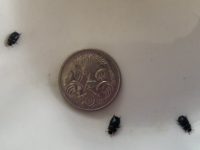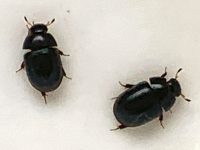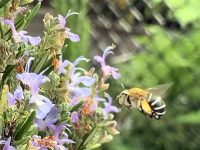Last minute reminder for Tasmanian people and visitors…… Koonya Garlic Festival is on Saturday, 29 February 2020. Lots of fun for everyone. Except vampires, they’re not going to like it much. For more information, visit the festival website at koonyagarlicfestival.org.
Workshop at Macquarie Point – insects
On Saturday the 7th of March 2020 Angus will be partnering up with some volunteers from the Tasmanian Museum, for a talk about the world of insects at the Macquarie Point Edible Precinct in Hobart, Tasmania. We will be looking at both friends and foes of the garden, and how to encourage the good ones and also releasing some beneficial insects such as ladybirds that feed on pests like aphids. My workshop runs between 11 and 1 at the Edible Precinct on the corner of Davey and Evans Street, Hobart, all welcome, no registration necessary. This event is part of the fascinating WORLD OF INSECTS photography and art exhibition which is on at Red Square in Evans Street at Macquarie Point from the 6th to the 9th of March, 2020.
Insects in your garden
We have been taught by efficient marketing people that we need to spray our house and garden to kill any sign of small life that has more than two legs, which is great for their profits, but not so great for either your health or the health of the environment. In spraying regularly, people kill not only the damaging creatures, but also the beneficial ones. But the trick in is knowing which insects are good and which are not.
Identifying your little garden creatures is the first step. I find doing a search on google images can often help, but not always. There is currently a bug from our worm farms stumping us as to whether it is one to squish or one to leave, and I have submitted the picture to the experts, as it could possibly be a hive beetle, which would not be a good bug to harbour. If anyone knows for sure what it is, send me an email on my contact page >>>
Museums can be a good place to go to identify your insect to see if it needs the squish or the encourage treatment, so if you can get a good photograph of your little creature, you could submit it to them. The following is a page full of information, photos and further links to various insect families at the bottom of the page for you to do your own identifying, which is a much quicker and easier process- https://australianmuseum.net.au/learn/species-identification/ask-an-expert/identifications-insects/
While it can be good to take a live and let live approach to your garden bug life, at times the bad guys can get the upperhand. This normally happens when things go out of balance….some of these things can include weather conditions altering, when there is an abundance of food, when predators are in short supply. Alternatives to insecticides can be trapping using their favourite food (watermelon seems to work for a lot of creatures), squishing (this is when we become the predator), sticky traps (you need to be very careful here though, as sticky traps can catch all sorts of good guys including birds and bats), supplying attractive habitat which can then be binned or cooked in the sun in a plastic bag or fed to chickens once colonised by your pest.
The popularity of ‘no work’ gardens has seen a lessening of flowering plants, and consequently less food for our insect friends. It is a good idea to consciously look for great habitat plants to add to attract them. Plants from the Lamiaceae (Mint) family are particularly attractive, and can be fairly fuss free (and delicious, as a lot of herbs like mint, basil, rosemary etc belong to this family). Check out the lovely blue banded bee that this rosemary regularly attracts, providing us with a great excuse to include a cute insect picture in this newsletter. This one is a girl, as it has 4 blue stripes, the males have 5-
Just one more thought as you wander the garden examining your insect populations, it is being said that eating insects may be the way of getting our future protein needs…….perhaps a little bit of revenge if you have ever seen the results of a hungry horde of caterpillars or grasshoppers on your plants!



